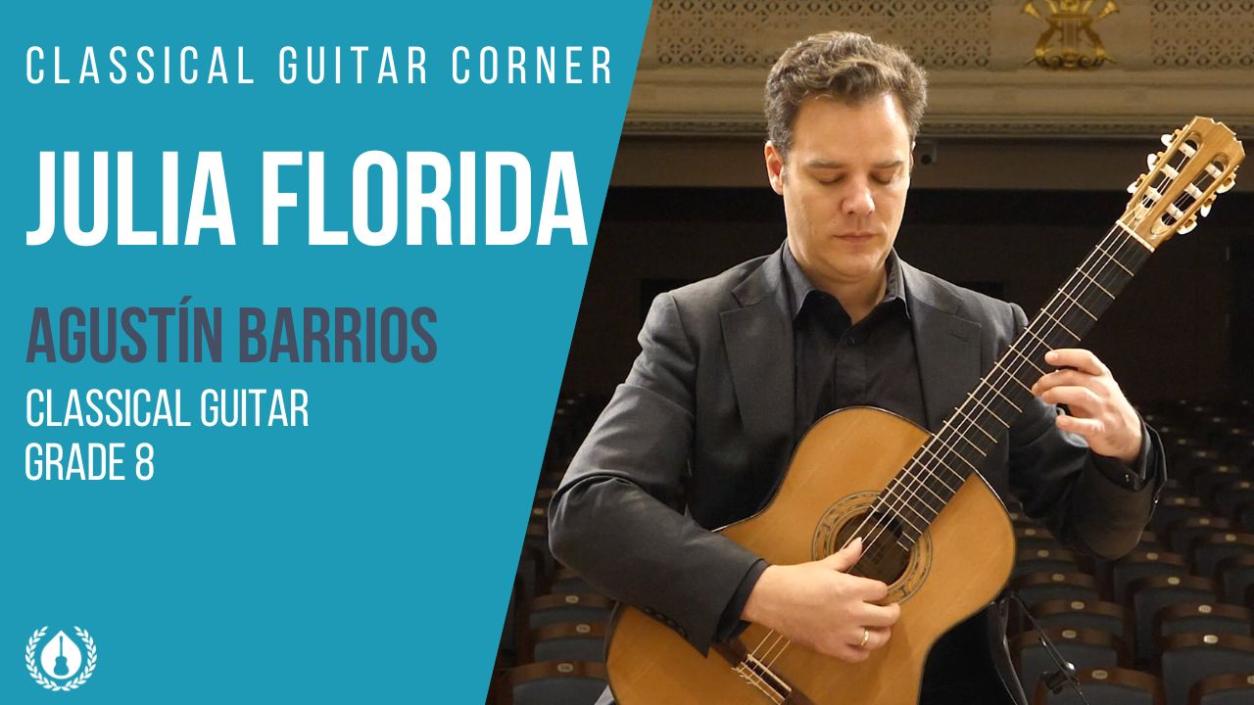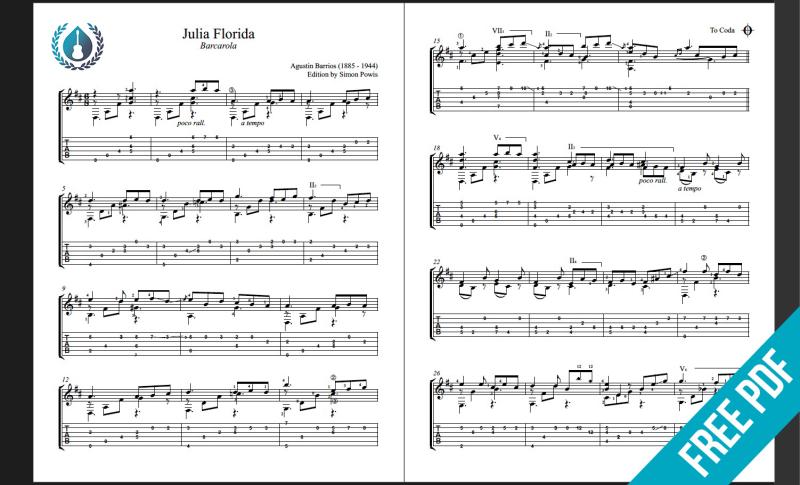The Serenade of the Heart: Exploring Julia Florida by Agustín Barrios Mangoré
Agustin Barrios Mangore stands as one of the most revered figures in the world of classical guitar. A Paraguayan composer and virtuoso guitarist, Barrios left behind a rich legacy that continues to inspire musicians around the globe. Among his extensive catalog of works, Julia Florida holds a special place. To this day it captivates both performers and listeners with its poignant beauty and emotional depth. In this post, we’ll explore the history, structure, and interpretation of this beloved piece, shedding light on why it resonates so deeply with those who encounter it.
Julia Florida performed by Simon Powis
Download the Sheet Music for Julia Florida
This edition includes Standard Notation and TAB. Julia Florida comes from our collection Graded Repertoire for Classical Guitar.
Historical Background
The origins of Julia Florida are steeped in a blend of mystery and romanticism, much like the composer himself. Written in 1938, the piece is often referred to as a “barcarola,” a term that traditionally describes a song with the gentle, rocking rhythm of a boatman’s song. This choice of form immediately evokes a sense of tranquility and wistfulness, setting the tone for the entire composition.
The title, Julia Florida, has sparked much speculation over the years. Some believe that Julia was a young woman who Barrios admired. Others suggest that the name represents a more abstract muse, embodying the purity and beauty that the composer sought to capture in his music. Regardless of the specific inspiration, it’s clear that Barrios poured his heart into this piece, creating a musical portrait of love, longing, and delicate sentiment.
Barrios’ cultural background played a significant role in shaping his musical voice. Growing up in Paraguay, he experienced the rich folk traditions of his homeland. In Julia Florida, one can hear the influence of these traditions, combined with the romanticism of European classical music. This fusion of styles is a hallmark of Barrios’ work, and it gives Julia Florida its unique, evocative character.
Musical Analysis
Julia Florida is a masterclass in lyrical composition, and its structure reflects Barrios’ skill in creating deeply expressive music. The piece has two main sections, each offering its own thematic material while maintaining a cohesive overall narrative.
The opening section introduces the main theme, a gentle, flowing melody that immediately captures the listener’s attention. This melody is supported by a rich harmonic foundation, with Barrios employing a series of lush, yet subtle, chord progressions. The use of chromaticism and occasional modal shifts adds an element of surprise, keeping the listener engaged and enhancing the piece’s emotional depth.
As the piece progresses, the melody undergoes various transformations. Barrios introduces slight variations that add to its complexity and beauty. The accompaniment, characterized by its lilting, rhythmic pattern, further reinforces the barcarola feel. It evokes the image of a gondola gliding smoothly over calm waters. The rhythmic interplay between the melody and accompaniment is crucial in maintaining the piece’s serene atmosphere, while also allowing for moments of tension and release.
One of the most striking features of Julia Florida is its harmonic language. Barrios was known for his innovative use of harmony, and this piece is no exception. The harmonic shifts are subtle yet powerful, guiding the listener through a journey of emotions without ever feeling forced or abrupt. These shifts, combined with the piece’s melodic and rhythmic elements, create a tapestry of sound that is both complex and accessible.
Interpretation and Performance
For guitarists, Julia Florida presents both technical and interpretive challenges. The piece demands a high level of control and sensitivity, particularly in the right-hand fingerpicking patterns. The arpeggiated accompaniment must flow smoothly, providing a steady rhythmic foundation without overshadowing the delicate melody. Achieving this balance requires a nuanced touch and a deep understanding of the piece’s emotional core.
The left-hand technique is equally important, with frequent shifts and stretches that can test a player’s precision and agility. Barrios often employed unusual fingerings in his compositions, and Julia Florida is no exception. Mastering these fingerings is essential for achieving the smooth, legato lines that are characteristic of the piece.
Beyond the technical aspects, Julia Florida demands a profound emotional engagement from the performer. The piece is a serenade in the truest sense of the word, and its success lies in the player’s ability to convey the tenderness and longing that Barrios infused into every note. This requires careful attention to phrasing, dynamics, and tone color. The melody should sing, with each phrase shaped to reflect the ebb and flow of the music’s emotional narrative.
Historical performance practice can also inform a modern interpretation of Julia Florida. Barrios was known for his expressive playing style, often bending the tempo to heighten the emotional impact of a phrase. While today’s performers may approach the piece with a different aesthetic, studying Barrios’ own recordings can provide valuable insights into the interpretive possibilities of the work.
Impact and Legacy
Since its composition, Julia Florida has become a staple of the classical guitar repertoire. Its popularity among guitarists is a testament to its enduring appeal. And it continues to be a favorite in both concert settings and private practice. The piece’s lyrical beauty and technical demands make it a rewarding challenge for players at all levels, and its emotional resonance ensures that it remains a powerful experience for audiences.
Barrios’ influence extends far beyond Julia Florida. His innovative approach to composition and performance has left an indelible mark on the world of classical guitar. He continues to inspire generations of musicians. The fusion of folk elements with classical forms that characterizes Julia Florida can be seen in the work of many contemporary composers, who continue to draw on Barrios’ legacy in their own music.
Moreover, Julia Florida holds a special place in the cultural heritage of Latin America. It is a piece that speaks to the universal themes of love and longing. Yet it is deeply rooted in the traditions of its time and place. In this way, Julia Florida transcends the boundaries of genre and geography, offering a glimpse into the soul of its composer and the world he inhabited.
Conclusion
Julia Florida is more than just a piece of music. It is a serenade of the heart, a lyrical expression of love and longing that continues to captivate listeners and performers alike. Through its delicate melody, rich harmony, and rhythmic grace, it offers a profound emotional experience that resonates across cultures and generations.
Whether you’re a guitarist looking to add this gem to your repertoire, or a listener seeking to deepen your appreciation of Barrios’ work, Julia Florida is a piece that invites exploration and rewards careful study. Its enduring beauty and emotional depth ensure that it will remain a beloved part of the classical guitar canon for years to come.



“Serenade of the Heart” is the perfect title for the article. Thank you for writing and sharing this!